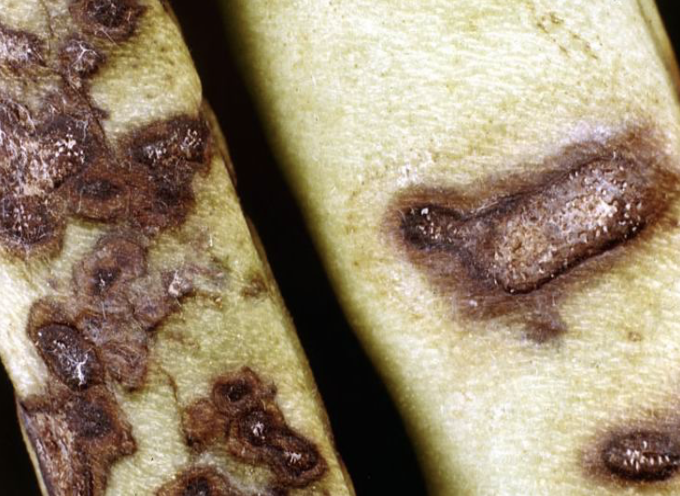Anthracnose (Colletotrichum gloeosporioides)
Credit: Biovision-Infonet

(c) A. A. Seif, icipe
This fungal disease is primarily a post-harvest problem when fruit is at maturity stage. Infection takes place when fruit is still very young and the fungus stays dormant till the fruit ripens. The disease appears as depressed spots on the fruit and the spots are manifested as a rot, which can penetrate deep into the flesh. In wet weather, the spots may be covered with mass of slimy, salmon pink fungal spore mass. The disease may develop very rapidly in storage if conditions in storage are humid and warm.
The anthracnose fungus lives saprophytically on twigs, rotten fallen fruits and dead or dying infected leaves. The fungus is spread by water splash.
What to do:
- Remove dead branches and twigs since they harbour the fungus.
- Remove fallen rotten fruits from the field.
- Apply copper-based fungicides pre-flowering, at fruit formation, and after harvest.
Anthacnose on Beans

(c) A. M. Varela, icipe

(c) Clemson university, www.bugwood.org
Symptoms of anthracnose can appear on any plant part. Pale brown sunken spots may appear on the cotyledons of infected seedlings. Water may spread the disease to the hypocotyl, which if girdled, kills the seedling. Lesions on leaves are dark brown. They are restricted to the veins on lower leaf surface. On stems, lesions are elongated and sunken. On the pods, the fungus produces black, sunken lesions. These lesions penetrate deep into the pods and may cause shrivelling of the young pods. Infected seed become discoloured changing to yellow through brown to black.
In damp weather, the centres of anthracnose lesions become covered with a pink spore mass. The disease is seed-borne.
What to do:
- Use certified disease-free seeds. Plant resistant varieties (e.g. French variety ‘Paulista’).
- Remove from the field and destroy crop debris after harvest.
- Practise a 2 to 3 year rotation.
- Avoid overhead irrigation.
- Avoid movement of workers in the field when wet.